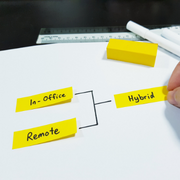Last week we asked you what your preference was for working location after the reintroduction of office working. With many companies adopting a hybrid approach to their organisations, we wanted to find out what you preferred. This is what you told us.
Over half of you (61%) voted for hybrid working, blending office and remote work. Unsurprisingly, people are increasingly favouring this new way of life after having a taste of a balanced approach throughout the pandemic.
33% of you voted for remote work full-time, while only 6% voted for the office full-time. Do you agree with the majority?
According to Zoom, 31% of all workers worldwide will be remote in 2022 (a mix of hybrid and fully remote). If your company has chosen to introduce a hybrid approach to their company, you may be looking for a way to help balance and manage your time better. We’ve compiled 5 top tips to help you do this.
1. Plan your tasks ahead of time
Once you’ve decided which days you’re going to be in the office, it will become easier to plan your work around your environment. Planning your days is a fundamental aspect of task management. You know yourself better than anyone else when it comes to your workflow. Ask yourself if you work more efficiently in the mornings. Perhaps you prefer to do your administrative tasks first thing then focus on more creative tasks in the afternoon.
Many people prefer to do analytical work, and written pieces, in a quiet space without any distractions. If you’re one of these people, then it may be helpful to set aside a meeting-free day on one of your home-working days to give you this space.
2. Schedule your time
Blocking out chunks of time in your schedule to focus on specific tasks is massively beneficial to your efficiency. Workers are adopting this method of task management to help keep on top of their goals, particularly when working from home by introducing start and end times for their tasks, as they would larger projects.
Setting boundaries such as turning off your phone, avoiding social media, and checking emails will help to keep your mind focused on your work. We can all sympathise with the distractions of working from home and getting disturbed by household chores or home life.
Top tip – download an app like TimeTree or Todoist to best manage your time.
3. Organise your workstation
Whether you’re working from your dining room table or are fortunate enough to have your own office within the house, try to copy your office setup as best you can. If you’ve got a dedicated desk area for working from home, have your workstation set up permanently and try to make it as similar as possible to your office desk.
According to Matt Perman, author of How to Set Up Your Desk, replicating your office’s desk setup will massively alter your productivity levels. In terms of organisation and ergonomics, Perman says this is an obvious solution that is often overlooked but hugely helps workers make the transition when adopting hybrid working.
4. Stay in touch
Remote working can be just that, remote. Even if you swear it’s better for your productivity, it’s not always beneficial for your mental health. Particularly if you live alone, it can be awfully isolating.
Remember to keep connected with your work colleagues. Utilise those chat tools and discuss your work, any problems you’re facing, and offer helps to others who you think may be struggling.
5. Coordinate your in-office time
If your company offers a more flexible approach to hybrid working where you’re able to choose your in-office days, it’s a clever idea to coordinate with your team when you’ll be in together.
Although there is lots of evidence that online collaborations are extremely productive, not everything is about productivity. And some things are simply better in-person. We can’t forget that a lot of important work relies on human connection and body language in order to read the room properly. Often humour and tone-of-voice are completely lost through digital communication, even over a Zoom call.
The changes in how work is performed compared to 2019 are truly incredible. However, this is still such a new concept in the grand scheme of things. Be patient with yourself and others while you come to adjust to your new way of working. Be open-minded to new methods and software and enjoy learning as you go. And never be afraid to ask for help when you need it.
Remote and hybrid working models are not going anywhere, the future is flexible. We hope some of our tips can help you improve your working from home structure, overall productivity, and of course, happiness.




